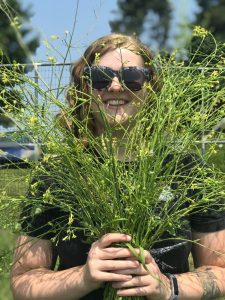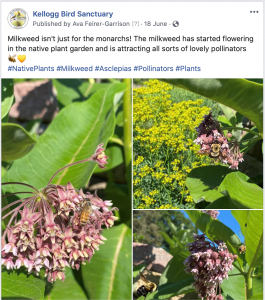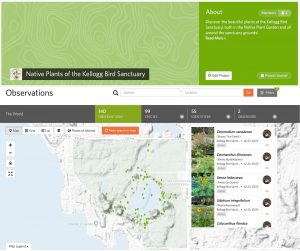Like many other people, I had to make some changes to my summer plans this year in light of the COVID-19 pandemic. When I applied for Kellogg Bird Sanctuary’s Native Garden Fellowship, the description included working in the garden with Bird Sanctuary volunteers and engaging with visitors about the native plants. But when it became clear that we were entering the summer of social distancing, my fellowship mentor, Lisa Duke, and I started making plans to change the shape of the fellowship. We quickly shifted gears and started brainstorming virtual experiences and self-guided tours for Bird Sanctuary visitors.
The most direct way to engage with visitors is through the Bird Sanctuary’s social media accounts, so part of my fellowship involved sharing pictures and facts about native plants around the Bird Sanctuary
grounds. But for visitors that come to the sanctuary looking to see certain native plants, Lisa and I wanted to make a virtual guide that allowed for self-directed exploration of the Sanctuary’s plants. So after exploring some options of apps that would help to accomplish this, we landed on iNaturalist, an app already in frequent use by KBSers and nature lovers. In fact, when I started tracking the native plants of the Kellogg Bird Sanctuary, I was daunted by the scope of the project. But soon former KBSer Thomas Koffel added his previously logged observations to the project and suddenly the project became real! Despite my efforts, he still remains the top contributor to the project.
The rest of my time was spent documenting the informational plaques on trees around the Sanctuary’s grounds. In the early days of the Kellogg Bird Sanctuary, its first director, George Corsan, planted trees all over the Sanctuary. Later, informational plaques were added to these trees with identifying information and facts about their growth and historical uses. I got to enjoy nice strolls around the Sanctuary finding these plaques, photographing them, and later compiling their information into one document. The information I gathered on the tree plaques is going to be integrated into a virtual tour using a platform called GIS StoryMap, by MSU undergrad and KBS intern, Maggie Haite. I’m very excited that what I did will eventually be a small part of what is sure to be an amazing virtual guide of the Kellogg Bird Sanctuary!
Despite the fact that it was not what I envisioned when I applied for the position, I could not have picked a better way to spend my summer than working as a Native Garden Fellow. I got to spend my time walking the gorgeous Sanctuary grounds, learning about Michigan’s native plants as well as trees from around the world. I’m so grateful to have had this peaceful, creative outlet in such a hectic and uncertain summer.
Ava Garrison is a PhD candidate at the Kellogg Biological Station studying the evolution of the agricultural weed Raphanus raphanistrum (weedy radish)




A legacy of conservation; a commitment to sustainability.
Kellogg Bird Sanctuary12685 East C Avenue
Augusta, MI 49012
Phone: (269) 671-2510 birdsanctuary@kbs.msu.edu